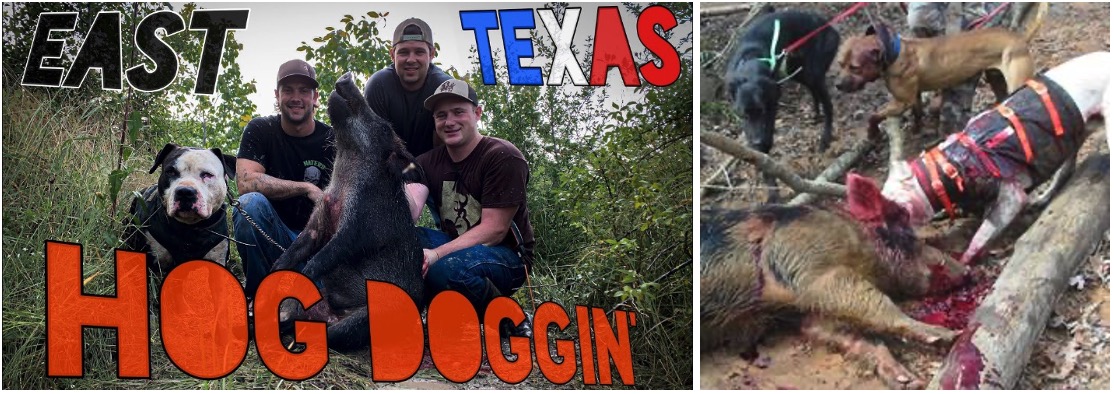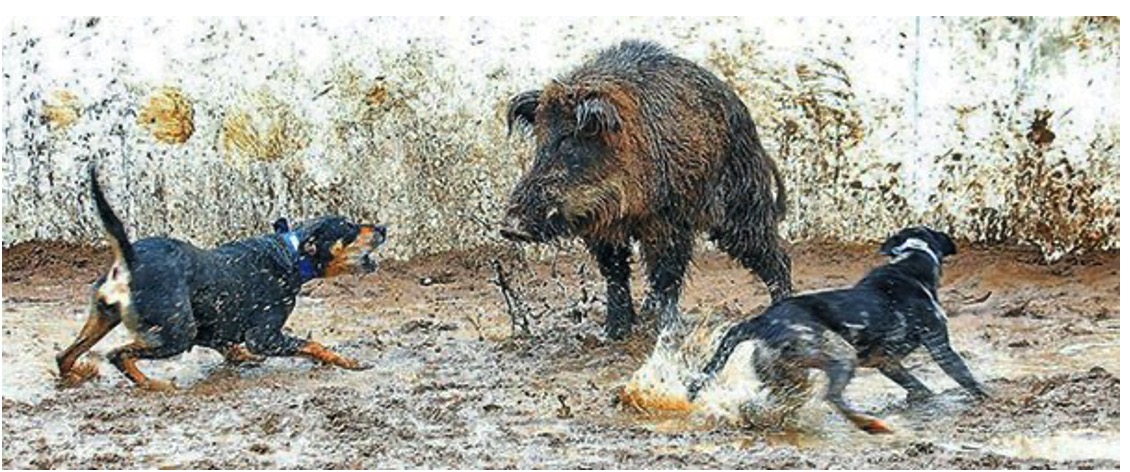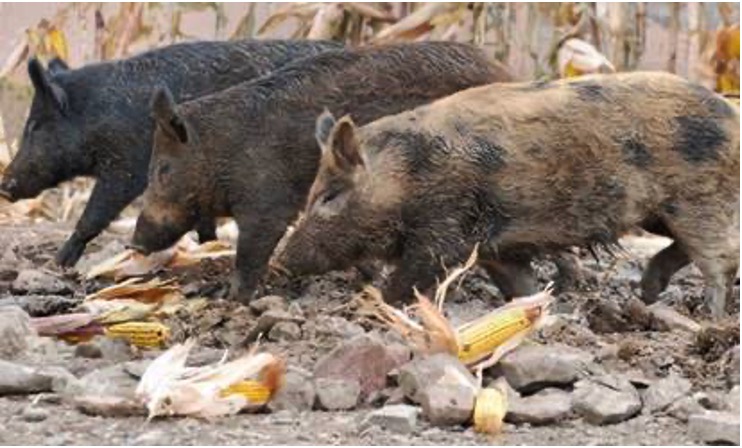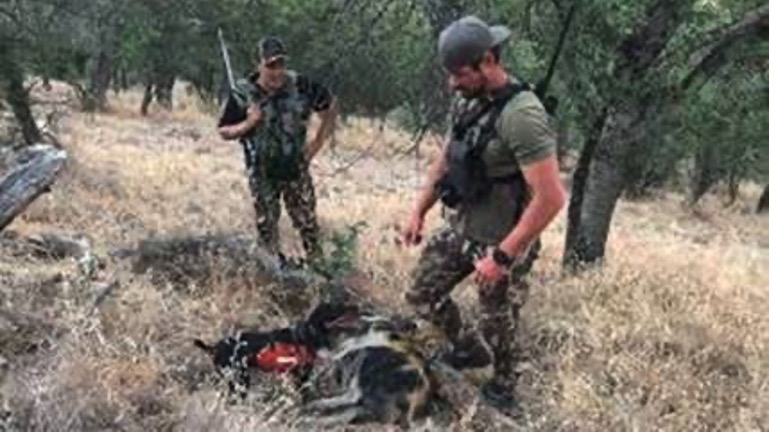Comments
ANIMAL WATCH - While dog fighting is the most noted “sport” involving Pit Bulls, there is another equally cruel pig-hunting activity known as “hog-dogging” for which this breed is trained and coveted. And, California’s governor Gavin Newsome just signed a bill that allows “hog-dogging” events to be increased.
HOG DOGGING: DOES IT MAKE CRUELTY LEGAL?
Hog-dogging involves the brutal hunting and injury to feral pigs inflicted by several Pit Bulls or other Bully-type dogs (Dogo Arentinos and Cane Corsos may also be used) which pin down the hog and brutally maul it while it’s still alive—after a hunter has used bolt cutters to remove the captured pig’s tusks so that it cannot defend itself.
The hunter then goes in for the kill, which is accomplished by stabbing the pig repeatedly until the knife goes into its heart.
This is merely a modern form of bull- or bear-baiting, during which the victim was restrained by a chain and Molosser-breed dogs were released to attack and kill it by ripping it to pieces.
Bear-baiting and bull-baiting were permanently outlawed by act of the British Parliament in 1835 as inhumane, by which time both had also been outlawed in most countries in northern Europe.
Yet, this despicable act involving the torture and suffering of a feral pig is not considered animal cruelty today in the U.S. and is publicly extolled on YouTube videos and other media formats. And, children are taken to these events to learn to enjoy the torture and suffering as the “mark of a man.”

Hog-dogging is openly alive and well all over the United States, with aficionados bragging openly and proudly on social media.
But it is not considered animal cruelty by the government because it is done under the guise of hunting and removing an invasive species—feral pigs—which were originally imported to provide food for early immigrants/settlers in the United States.
Hog-dogging is also an indicator of the genetic lust for the kill that was bred into Pit Bull ancestry, when they were engaged in the horrific bear-baiting and bull-baiting which tortured and killed animals that were chained in place in arenas for public entertainment.
WHAT OCCURS IN “HOG-DOGGING?”

There are two types of dogs used in each kill: “bay” dogs (commonly, Black Curs or Louisiana Catahoula leopard-dog types) to signal by barking and howling that a pig/boar has been located, often in thick brush; and the “catch” dogs, commonly Dogo Argentinos, Cane Corsos or Pit Bulls, released to run in and make the kill.
The victim is terrorized by the barking of the dogs and essentially immobilized by the attack tearing at its body and head, until the hunter comes in with a knife to stab it multiple times until piercing its heart or he/she may use a gun or bow and arrow to assure the kill. (Yes, there are women who enjoy this brutal and bloody spectacle.)
FERAL PIGS, WILD BOARS
Feral pigs in the U.S. can be traced back to 1539, when Spanish explorer Hernando DeSoto and his army landed at what is now Tampa Bay, FL., and brought with them as many as 300 wild hogs—which reproduce rapidly and survive on wild plants, small animals, and insects, and provided a source of protein for settlers.
The pigs could also be traded to the indigenous people as the groups migrated across the country to Mississippi, and, of course, many of the pigs escaped and reproduced in the wild.
According to Wild Pigs in the United States, feral hogs were reported from Georgia to California, brought by Spanish colonists.
It was also noted that, when French colonists arrived in Florida in the 1560’s, natives brought them food which included “fresh, wild pork.”
WHY KILLING OF FERAL HOGS IS ENCOURAGED

Feral hogs are omnivorous and survive on plants, smaller farm animals, wildlife, and insects, and strip areas of the natural vegetation, much of which cannot regrow because it has been uprooted.
According to the USDA, the damage feral swine cause is wide-ranging and far-reaching.
“With populations throughout the United States, this invasive animal—with few natural predators—negatively impacts everything from agriculture and the environment to human health and public safety,” the agency states.
“Feral swine can multiply faster than any other large mammal; females begin breeding at about 8 months and can produce 2 litters of 4–12 piglets every 12–15 months.” By the time the second litter is born, the pig may already be a “grandmother,” one report quips. The numbers are staggering!
The main reasons for their continually expanded range include accidental escapes or intentional releases from fenced facilities or people moving them illegally to new areas. Damages, costs, and risks from feral swine will only keep rising if their populations continue to expand, experts say, because they have no natural enemy.
They also spread disease. “Harmful organisms and pathogens, carried by feral swine, which can infect humans include diseases such as leptospirosis, toxoplasmosis, brucellosis, tularemia, trichinellosis, swine influenza, salmonella, hepatitis and pathogenic E,” the USDA reports. They “have now become a danger in at least 45 states”.
One of the most concerning habits of feral pigs is “rooting,” where they burrow their noses under the ground to consume the roots of indigenous plants that are vital to fire control, leaving behind a trail of dry brush and dead plants that cannot regrow.
This was one of the concerns in the 2022 Maui fires, where the feral pig population had multiplied uninhibited and the destruction to fire-resistant native plants may have allowed the spread of the fire.
See: Feral Hogs and the Deadly 2023 Hawaii Fire?
Sadly, these animals, in surviving, now overrun farms and, by uprooting and eating the tender and nutritious roots which are essential to their nutrition, are also destroying entire fields of crops.
A PLEA TO MAKE HOG DOGGING A CRIME – FLORIDA’S FERAL HOGS
(Posted by Sugar’s Hope, addressing a Florida Commission and provided below in pertinent part.)
It begins, “… I had the opportunity to read a letter to the County Commissioner regarding the legality of the hunt. I’m not sure who the author is, but the following passage raises some interesting questions:”
“Section 828.12 of the Florida Statutes defines ‘animal cruelty.’ It states that: A person who intentionally commits an act to any animal which results in the cruel death, or excessive or repeated infliction of unnecessary pain or suffering, is guilty of a third-degree felony.” the writer explains.
“It is a third-degree felony to kick an animal. How is THIS hunt not?”
“You have just seen the video footage; this practice is the epitome of ‘unnecessary pain and suffering.’ The dogs used do not just track the pigs; they are trained to attack them. Did you see the smiles on the hunters’ faces? Remember, people are paying to do this. This has nothing to do with necessity—this is a blood sport, with the consequence of lowering the hog population.”
“Remember the images: Packs of dogs tearing into a pig’s flesh, mutilating it and causing needless pain. This is to hold it in place while the human eventually catches up, and then proceeds to stab the pig repeatedly, trying to find its heart. And this is the BEST CASE scenario.”
“In the worst cases, the dogs themselves get gored, maimed, and killed in the struggle. Not to mention the danger of having humans in close-quarters knife combat with a wild animal.”
“Now, remember the language of the statute:
1) repeated infliction
2) unnecessary pain
3) cruel death”
“To be clear, the Florida Statutes allow the NECESSARY killing of animals, and I understand that the hog population must be controlled. However, the method of killing must be humane, and this is anything but humane.”
“Even if this were the most effective way to kill wild pigs, pure effectiveness is not the end-all-be-all of any regulatory scheme. Two of you are attorneys; I know you understand this.
I urge this Board to refuse to become accomplices to a practice that should be prosecuted as a felony. No, none of you is likely to be prosecuted, or even sued—qualified immunity takes care of that. But each of you is morally responsible for the consequences of your decision ….”

SEE A HOG-DOG “HUNT” HERE. (Warning: graphic)
You will hear one of the hunters’ son, who appears to be around 9-10 years old asked, “What are you gonna do when we get a hog? His answer is “Stab it!”
All states should make hog-dog fighting illegal like dog-on-dog fighting. Owners of hog dogs and participants of hog-dog fighting can be federally prosecuted if they are found to be transporting their dogs or hogs for hunting over state lines, according to the Animal Welfare Act, but it is up to state legislatures to create laws that punish people for a cruel and unacceptable practice within a state.
HUMANELY TRAPPING LARGE NUMBERS OF FERAL PIGS MOST EFFECTIVE
This video by Jager Pro provides a visual lesson and also the educational factors in capturing large numbers of feral hogs at a time humanely. It is not necessary to place the animals—nor dogs, which are often hurt or killed in subduing the hog—under the stress and pain of “hog dogging.”
AnimalBlawg urges using humane methods to address this problem:
“The overpopulation of feral hogs was caused by humans importing them, and the poor creatures should not be murdered and brutalized because people were negligent in understanding hogs’ behavior and quick reproduction rates when original ‘wild’ populations were introduced for hunting purposes.”
“Though these “wild” hogs cause widespread and costly damage, there can be far more humane methods to addressing the over population and damage concerns…even if they must be killed on sight, it does not have to be done in such a barbaric manner.
Instead hogs can be euthanized without the fear and pain that comes with the hog dog hunting and fighting process.”
Gov. Newsom Signs Bill to Increase Hunting CA Wild Pigs

Bay City News Service (Updated January 23, 2024)
“A bill addressing how to handle up to 400,000 wild pigs that are roaming across California has been signed into law by Gov. Gavin Newsom,” according to the Bay City News on January 23, 2024.
Senate Bill 856 will “loosen regulations and lower hunting fees for killing the wild pigs, which have been found in 56 of the state’s 58 counties, excepting only San Francisco and Alpine counties,” the report says.
There was no vote in either the House or Senate opposing the bill, which allows killing an “unlimited number of wild pigs,” as well as “prohibiting intentional release of a pig to live in the wild.”
“The growing number of the pigs isn’t just a California problem—they were found in 544 counties nationwide 40 years ago, but are in 1,915 counties as of 2020,” said Ari Cornman, wildlife advisor for the Fish and Game Commission.
Seemingly the Governor has not considered—or is ignoring—the fact that one pig at a time will not deplete the population.
“Roger Baldwin, a professor at University of California, Davis specializing in human-wildlife conflict, reported that some other states don’t allow wild pig hunting at all, finding that the pig numbers grew and popped up in new places because people were transporting the animals around for hunting opportunities,” according to the Bay City News.
One thing is certain: As long as a powerful hunting lobby, which benefits economically from the problem in multiple ways, is providing the solution, it is unlikely California pigs will decrease.
But a more important consideration is that any plan which involves, or allows, “hog-dogging”—is complicit in and condoning blatant animal cruelty.
(Phyllis M. Daugherty is a former Los Angeles City employee, an animal activist and a contributor to CityWatch.)






